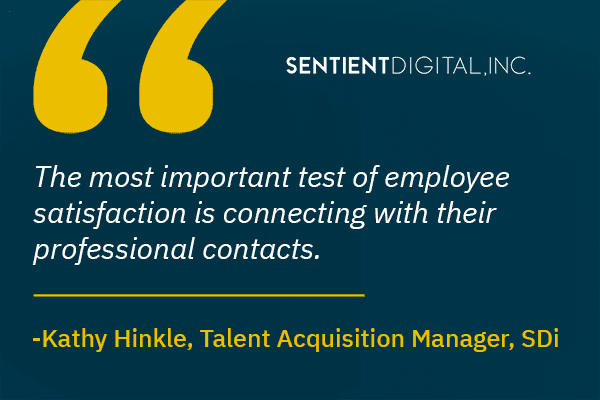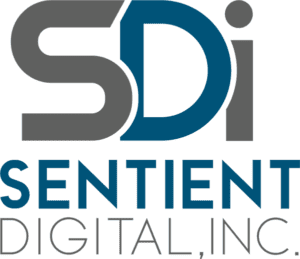For employers interested in leveraging their employees’ contacts to hire the best candidates, Sentient Digital’s experience serves as a useful employee referral case study. Recently, Sentient Digital hired four candidates who were referred by employees. The success of this program provides valuable insights into best practices for implementing this type of program, as can be seen in this case study.
Lessons from the examples of referral programs can help businesses better implement their own programs or improve their existing programs. These valuable insights can provide ideas to shape a successful employee referral program in which employees will participate. This can include understanding the best ways to communicate the program to employees, learning about different types of incentives, and identifying key metrics to measure the success of the program. Additionally, studying other companies’ referral programs can also help businesses avoid common mistakes, and ensure that their own program is effective and efficient, potentially saving time, money, and resources. This post will use Sentient Digital’s employee referral case study to explain the benefits of employee referral programs and how to best implement your own program.
The Value of an Employee Referral Case Study
There are a lot of good reasons to consider an employee referral case study before jumping into your own referral program process. Paying attention to real-world examples of how a program has been implemented and the results that were achieved can give you a better idea of what you need to think about when crafting your own program. A case study can provide inspiration and ideas for how to design and implement a referral program at your own company. If you need to achieve buy-in for your employee referral program implementation effort, showing positive results from another organization may help your case. Most importantly, a case study can help you understand the benefits of an employee referral program.
Benefits of Employee Referral Programs, Both For Businesses and For Employees
Employee referral programs have potential benefits for the referring employee, the referred candidate, and the employer. These programs can help an organization recruit highly qualified candidates who are more likely to be a good fit for the organization’s culture and values. Additionally, referred candidates may be more engaged and motivated to join the company, because of the respect they have for the employees who referred them.
Employees who are referred to an organization tend to stay with that organization longer than employees recruited via other methods.Reducing turnover helps your organization avoid the costs of recruitment and training new employees. Employee referrals also help to build a positive reputation for the company in the industry, as referred candidates are likely to share their positive experiences with others.
In addition to the potential for financial benefits and recognition, employees who participate in an employee referral program further demonstrate their own value to the organization by referring candidates that are a good fit for the job. At its best, an employee referral program will be a win-win for employees and employer, so reviewing a case study may prove helpful in implementing your own.

Sentient Digital: An Employee Referral Case Study
Sentient Digital runs its referral program with the philosophy that “good people know good people.” This means that if you trust your employees to do a good job at work, you should also trust their ability to recommend good candidates for employment.
We strongly value employee satisfaction and our referral program is just another manifestation of that value. Kathy Hinkle, Sentient Digital’s Talent Acquisition Manager, explains, “The most important test of employee satisfaction is connecting with their professional contacts.” Employees’ positive opinion will be reflected in what they have told their contacts about working at the company.
Sentient Digital’s referral program offers employees a bonus as an incentive for referring a successful candidate for employment. We promote the program on our intranet to make sure employees are aware of the opportunity. We also use the intranet to celebrate referral program wins so that all employees know that our program works.
We recently hired a total of four candidates that were referred by our employees and we want to keep this going. These specialists ranged in job area and job title, showing that the referral program worked for different subject matter expertise and job level.
We let our employees know about these referral successes in a post to the intranet that encouraged them to refer qualified people as the program continues. This success story shows that when you demonstrate that you value employee referrals and follow through with those referrals, your employees and the organization as a whole can benefit.

How To Build A Successful Employee Referral Program
To begin a successful employee referral program, leadership first needs to clearly define the positions for which referrals will be accepted. This should include the specific skills and qualifications that are required for the role, and the desired levels of experience and education. The more specific you can be, the better chance of finding candidates that fit the position requirements as well as the organizational culture via these referrals.
The next step is to determine what incentives you will offer to employees for referring successful candidates. You should consider financial and non-financial incentives. A mixture of both, such as giving a bonus and recognizing the referring employee in an internal communication, may work best. For example, at Sentient Digital, in addition to our financial incentives, we sent out an intranet post announcing the hires and by whom they were referred.
Next comes the absolutely critical step of communicating the details of your referral program to your employees. This step can make or break your program, because if employees do not have a full understanding of the kind of candidates you need, they will not be able to recommend the best possible candidates. You will need to communicate both the existence of the program and the available incentives, but also the details of the specific positions for which you are seeking referrals, to help employees evaluate whether their contacts fit your requirements.
Keep track of the progress of the employee referral program, including the number of referrals, who made the referral, and whether the candidate was hired. As you track these items, keep employees informed about the status of their referrals; this will show them that you appreciate their recommendations, even if you ultimately end up hiring someone else. This data can also help you make adjustments to your communication or incentives over time to produce the best results.
Finally, it is important to celebrate the success of the employee referral program. Recognize employees who have referred successful candidates and announce milestones such as the number of new hires made through the program. In Sentient Digital’s case, we used the intranet post both as a way to thank the employees who referred the successful candidates and as a way to remind other employees about the program.
5 Challenges and Obstacles to Overcome
Of course, with any new program there are sure to be challenges and obstacles. By learning about these common issues, however, your organization can better avoid falling prey to them yourselves. Not only that, but you can potentially create a more thoughtful, successful employee referral program from the very start.
1. Low Employee Participation
First and foremost, an employee referral program will not work if no one participates. There are numerous different possible reasons for low participation, including:
- Lack of awareness about the program
- Misunderstandings about the program
- Lack of motivation to participate
- Discouragement over a complicated process
To resolve this issue, an organization should first identify why participation is low. Ask employees one on one when given the chance or solicit feedback anonymously from staff about the program. If it proves too difficult or time-consuming to get to the bottom of the issue, you can also try implementing solutions to the most common problems.
- If staff lack awareness, schedule regular reminders, especially whenever you’re hiring
- If staff misunderstand, correct common misconceptions and create an FAQ for employees to reference
- If staff aren’t motivated, consider amplifying the current incentives or replacing them with others
- If staff are discouraged, simplify the process or offer dedicated time to help walk them through it
2. Properly Managing Expectations
Once you have buy-in from staff about your program, you run the risk of disappointing them if it doesn’t work out how they had hoped. This is why it’s crucial to properly manage expectations. Team members who refer someone they care about and would be excited to work with—such as a friend, family member, or professional connection—could have their hopes dashed if their referral isn’t hired. Or, if the incentives for participation are high, employees may have their sights set on a reward that they could be disappointed to not receive.
To avoid these issues:
- Create clear guidelines for referrals and rewards
- Set realistic expectations
- Communicate about the hiring process, including your typical timelines and outcomes
- Establish how much current staff can expect to know about their referral’s status and provide timely updates whenever appropriate
3. Low Quality Referrals
If quantity of referrals is not an issue, it’s always possible that quality will be. This can occur when current staff do not have a good understanding of the job requirements or if they are simply trying to get the incentives by submitting any candidate possible without worrying about whether it’s a good fit.
There are a number of ways to improve the quality of employee referrals, such as:
- Emphasizing the importance of referring quality candidates and any stipulations in the rewards that hinge on candidates being hired
- Providing clear, easily accessible information about the qualifications for any open job positions
- Offering feedback to current staff about any job candidates they refer
4. Potential Bias and Lack of Diversity
If your current workforce shares similar demographics, such as race, gender, age, or educational attainment, employee referrals can further perpetuate a lack of diversity. Staff may inadvertently refer people who come from similar backgrounds as their own. When a significant number of hires come from such referrals, your team can become homogenous—not just in its background, but also in its knowledge, skills, and experiences. With fewer new and different ideas, innovation can stagnate at an organization.
Consider ways to intentionally counteract this possibility:
- Make real efforts to promote your job openings among more diverse communities, rather than relying too heavily on employee referrals
- Offer additional incentives to staff whose job candidate referrals support your diversity initiatives
- Collect and review data on your employees’ demographics, especially regarding new hires from the employee referral program, and adjust your hiring practices as needed
5. Program Oversaturation Over Time
When an employee referral program is first established, it can create an influx of qualified candidates. Staff who were never motivated to refer candidates previously have an entire untapped network to consider for referrals. However, as time goes on, many employees will have already recommended the people in their network who could be a good fit. Unless your organization opens up new kinds of job positions it hadn’t offered before, your current staff network with more people, or more people in your current staff’s networks look for work who hadn’t been looking before, referrals can start to dwindle.
While challenging, there are ways to overcome this issue, such as:
- Encouraging networking among your staff
- Providing reminders or new rewards when referrals decrease
- Partnering with professional associations or community groups to create a broader referral network
Non-Financial Incentives to Consider Offering
As mentioned previously, non-financial incentives can be a win-win for your organization and its staff. You can encourage the employee referrals you’re looking for without spending money, and your staff can enjoy additional perks and motivators. Of course, many staff will prioritize financial incentives such as bonuses, so the best programs tend to include a mix of both. But non-financial incentives give you ways to support these efforts without having to just spend money to see results.
1. Extra Vacation Days
Who doesn’t love more vacation? This is one of the most heavily coveted employee benefits, and as long as your team is large enough to cover each other’s work effectively while staff are out of office, it comes at relatively little cost to your organization. Extra vacation days can make a significant impact on an employee’s work-life balance, and they can be an incredibly strong motivator. Staff will generally be very appreciative of this incentive, rewarding them with more personal time in exchange for helping your organization grow.
The exact PTO exchange you offer will depend on the size of your organization, the amount of PTO you already offer employees, how much you value employee referrals, and more. It is also important to put some restrictions on this policy to ensure good outcomes. As an example, you could institute the following policy:
- Any staff member who successfully refers a job candidate to our organization will receive 1 extra vacation day.
- In order to be considered “successful,” the job candidate must 1) be hired by our company and 2) stay at the company for at least 6 months.
- Employees can receive no more than 3 extra vacation days via this policy each year.
- Extra vacation days earned through this policy do not roll over to the next year.
2. Public Praise or Recognition
For some employees, praise and recognition can go a long way. It acknowledges their hard work and commitment to the organization’s success, which can boost their morale, enhance their sense of value and job security, appeal to their pride in their work, and underscore their sense of achievement and belonging. Not only does public praise and recognition reward the employee at hand, but also it can get others excited to participate in the employee referral program. The rest of your staff get a reminder of the program and its value to the company, encouraging them to recommend a job candidate as well.
Ways to incorporate public praise and recognition include:
- Giving staff a shoutout for referring a job candidate during a company meeting
- Putting praise in your internal company newsletter about any staff who refer job candidates
- Sharing your appreciation in real time over Slack or any other remote communication platform your organization may use when a staff member refers a job candidate
3. Professional Development Opportunities
Professional development benefits your staff as well as your organization, making it an especially appealing incentive to offer. It creates a satisfying and highly productive cycle of growing your organization. You reward staff for improving your team with new, highly knowledgeable and skilled members, while also re-investing in your current team’s professional development. Not only that, but it also shows current staff that you are willing to invest in their growth and career interests, which can motivate them to want to improve their skills and stay at your company. This is a great way to create more career opportunities for your staff by advancing their professional skill set.
For example, in exchange for quality job candidate referrals, you can grant credits to the staff who referred them. These credits can be used for approved professional development opportunities, such as online courses, certifications, workshops, conferences, or seminars. For best results, come up with appropriate criteria for approved opportunities. This could be as restrictive as allowing employees to choose from a predefined list of opportunities, or as open-ended as simply giving a budgetary constraint. In either case, give yourself room to reevaluate your criteria over time depending on how motivating it is to staff and whether it causes any issues.
How to Implement Non-Financial Incentives
While the specifics will vary depending on the incentive itself and your organization, there are a few key strategies to keep in mind:
- Learn what will motivate your employees. This will depend on what your unique employees value, as well as what your company culture promotes as valuable. For example, some workforces may value work-life balance above all else and appreciate additional PTO the most. Others may be more career-oriented and appreciate opportunities to develop their skills and advance their careers. Consider taking an open-ended survey to generate ideas, using a poll to choose between a set list of options, questioning a few select employees, or testing out incentives and pivoting as needed.
- Communicate clearly about the incentives and any requirements. Don’t leave room for doubt, confusion, or loopholes. This can lead to disappointment from employees who misunderstood the parameters of the program. Keep written or digital records of how the incentives work that are easily accessible by your employees.
When non-financial incentives align with your company values and staff desires, they can significantly increase employee participation and satisfaction in referral programs.
Why The Incentives Offered For Employee Referral Programs May Provide a Significant ROI
Starting an employee referral program will involve an investment on the part of the employer. This doesn’t necessarily need to mean money; you can use non-financial incentives like praise, awards, and so on, but this will likely involve an investment of other resources such as time. Offering the right incentives for referrals could ultimately attract the best talent to your organization, so it’s worth examining the reasons to offer these incentives.
The right incentives can increase employee motivation to take part in the program. When employees are offered rewards for referring candidates, they may be more likely to do so. You know your employees best, so you know what rewards will work for them. Having a reward system backing your employee referral program can lead to a higher number of referrals, and ultimately a larger pool of qualified candidates to choose from.
When it comes to the results achieved with these incentives, employee referrals may yield more successful employees than other recruitment methods. This makes them worth the effort, because your employees may be more likely to refer candidates who are a good fit for the company culture and have the necessary skills and experience for the job. This can lead to a higher success rate in terms of hiring the right candidates for the organization.
That leads into another benefit of investing in employee benefit programs, which is that the investment can actually save your business money over time. The cost of hiring the wrong person can be enormous, so investing in a successful employee referral program can pay off in the long run.
Finally, keep in mind that in addition to helping you obtain better job candidates, these employee referral incentives are an expression of your trust in your current employees. Sentient Digital knows that when employees see that their opinions are valued, this can increase employee satisfaction.
Want To Work With A Company That Values Your Skills, Your Advice, and Your Connections?
Sentient Digital’s employee referral case study shows that our leadership not only values our employees’ skills but also their opinions and connections, to the benefit of all. We appreciate receiving a recommendation from our employees about who would make a great addition to our team. We want our employees to have the work-life balance that, among other benefits, lends itself to building relationships that may yield valuable connections. This is just one example of the company culture that makes Sentient Digital a great place to work. Want to learn more? Check out our current job postings.



